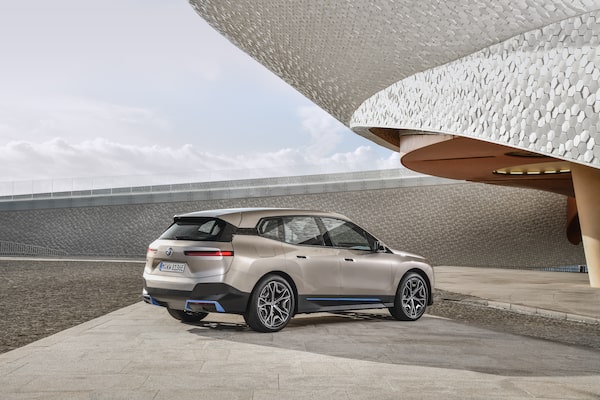
The 2022 BMW iX.Courtesy of manufacturer
Did BMW’s original electrified i-cars blaze a new trail or lead the brand up a blind alley? Until now, the evidence might seem to indicate the latter. Maybe, however, the forthcoming iX electric crossover, unveiled in Munich yesterday, will yet vindicate BMW’s confidence in its technological leadership.
Time will tell. The iX is still at least a year away from launch, but remember – nobody much liked the screen-based iDrive interface when BMW first conceived it nearly two decades ago; now every automaker has embraced the concept.
First, a little backstory. BMW was among the first mainstream automakers to go electric when it launched the i3 (and the plug-in hybrid i8) in 2013. The first i-brand cars truly were visionary, born of an environmentally holistic approach that embraced their entire life cycles, from manufacturing to eventual recycling. By luxury-brand standards, they weren’t even particularly expensive. The i3 currently starts at just under $45,000 in Canada – the same as a Hyundai Kona Electric or Nissan Leaf Plus.
But the way BMW packaged its electrified twosome was as unconventional as their technology – the i3 had an urban runabout style that looked peculiar and targeted a subcompact segment now in its death throes (at least in North America). The i8, on the other hand, was a visually stunning exotic sports car, but too expensive and impractical for all but a tiny sliver of the market.
All this in a market, meanwhile, going mad for utility vehicles. Tesla, Jaguar, Audi, Mercedes and mostly recently Volvo have all launched battery-electric vehicles that are – to varying degrees – shaped like SUVs.
Meanwhile, BMW seems to be still working its way through a prolonged process of teasers and previews. More than two years ago, it showed the iNext prototype of an SUV destined to be on sale in the calendar year 2021. Now here’s the iX – a preview of that electric SUV (or SAV in BMW-speak) in its final form, still scheduled to land in 2021, albeit late in the year (and more likely early 2022 in Canada).
The iX represents the second phase of Project i, BMW’s electrification strategy, and incorporates and advances many of the principles embodied in the i3 and i8. Its shape shares the footprint of a current X5 but the lower roofline of an X6 and is dominated by the prominent grille first seen on the iNext concept (and contentiously now in production on the 4 Series coupe).
Hopefully the iX will embody the principle, “if you can’t be first, be better.” Beyond an impressive range projection of at least 480 kilometres, BMW says the iX will be a technology flagship for automated driving, connectivity and sustainability – “the first representative of a trailblazing generation of cars poised to redefine the driving experience, the feeling of space inside and the relationship between vehicles and those on board.” Likewise, the i brand is BMW Group’s designated “'workshop for the future' and driver of innovation across the company.”

The iX features the divisive enlarged kidney grille seen on the new 4 Series.Courtesy of manufacturer
The iX itself debuts what BMW calls a new, modular, scalable tool kit – designed specifically for electric vehicles – on which the future of the BMW Group will be built. In a marked departure from the traditional long-hood motif of BMW design (driven in part by the length of inline six-cylinder engines), the iX’s electric powertrain allows the A-pillars to be pushed well forward to liberate more interior space.
Beyond roominess, the space itself promises “a new type of bond between occupants and vehicle.” The displays and controls are stripped down to the bare essentials, manifesting themselves only when actually needed. Sustainability informed the choice of interior materials, including a natural olive-leaf extract treatment for the leather that avoids harmful residues while enhancing appearance. Built-in speakers will be available for the front seats.
About that grille: BMW calls it “a technologically lavish advertisement for intelligent mobility” that, freed from the need to flow cooling air for a combustion engine, instead houses many of the cameras and sensors that enable advanced driver-assistance systems (ADAS) and, ultimately, fully automated driving.
Like that of the i3, the body structure’s weight optimization recruits materials as diverse as steel, aluminum, thermoplastics and carbon fibre, and the claimed drag coefficient of 0.25 is exceptionally low for an SUV-ish vehicle. The electric motors – one on each axle – are made without rare earths, while the batteries are said to be highly recyclable and manufactured using only renewably-sourced electricity. Additionally, BMW has contracts that ensure responsible sourcing of socially and environmentally contentious materials such as cobalt.

Courtesy of manufacturer

The interior is minimalist, with materials selected for sustainability.Courtesy of manufacturer
On the practical side, DC fast-charging capability of up to 200 kW (where available) will restore 120 kilometres worth of charge in just 10 minutes or boost the state of charge from 10 per cent to 80 per cent in 40 minutes. A full recharge at home using an 11-kW wallbox should take less than 11 hours.
Performance? BMW projects combined motor outputs of at least 500 horsepower. As for BMW’s traditional sheer-driving-pleasure proposition, “We will continue to prove that driving pleasure does not conflict with sustainability,” promises board member Pieter Nota.

Courtesy of manufacturer
Shopping for a new car? Check out the Globe Drive Build and Price Tool to see the latest discounts, rebates and rates on new cars, trucks and SUVs. Click here to get your price.
Stay on top of all our Drive stories. We have a Drive newsletter covering car reviews, innovative new cars and the ups and downs of everyday driving. Sign up for the weekly Drive newsletter, delivered to your inbox for free. Follow us on Instagram, @globedrive.